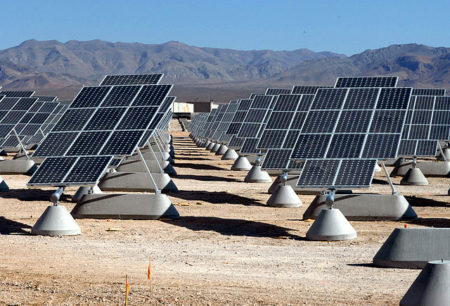By Tiffany Hsu June 20, 2016
 Biofuel algae. ©AgriLife Today“>By USAF – 070731-F-8831R-001
Biofuel algae. ©AgriLife Today“>By USAF – 070731-F-8831R-001The renewable energy industry is full of compelling stories for journalists to tell. Tales of prospectors, abandoned projects and risk-taking cowboys abound—just take the gold miner and Caltech-trained geologist who is trying to turn a Mojave Desert ghost town into a clean-tech mecca.
But it’s not just about new technologies, bold entrepreneurs, and big ideas. You’ve also got divisive politics, high-stakes lobbying, tax breaks and big investment. The visuals are often powerful, too—towering turbines, vats of algae biofuel and acres of glinting solar panels—which makes these stories ideal for multimedia representation.
But because so much of the technology is new and heavily politicized, it can be tough for even the most dedicated journalist to get the real story. Reporters often don’t have the scientific or technical background to challenge sources. Attitudes towards developments in the industry can seem to swing from hype to obituary and back.
All of which makes the renewable energy beat both exciting and challenging to cover. Here are some tips on how to do it right.
WHAT IS IT?
This is the beat of many names. Renewable energy is also referred to as alternative or green power. And, often, it’s lumped into broader clean-tech coverage that includes energy efficiency, electric vehicles and other eco-innovation.
There are several unique sub-industries, including solar power, wind, biomass, geothermal and hydro. Each involve different technologies, applications, sources, opponents, etc.
It helps to have some background in traditional energy coverage — interest in renewable energy tends to move in tandem with oil prices. Proponents of fossil fuel independence are especially vocal when pump prices rise.
WHY SHOULD WE CARE?

Elon Musk ©Rich Talk
Renewable energy isn’t always sexy. Not every company has a patron saint like Elon Musk, the real-life Tony Stark who helped launch Bay Area solar power company SolarCity. Not all biofuels will be as wacky as the surplus wine used to run Prince Charles’ Aston Martin.
Day-to-day reporting can be heavy on numbers, science and speculation. A new technology might spend years mired in the so-called research and development valley of death before slogging through beta testing or limited launch. Waiting for the payoff that comes with a major utility contract and mainstream adoption requires a kind of patience and attention span that many editors and readers lack.
Each publication will have a different appetite for renewable energy coverage, of course. Know your audience—make sure that each story is relevant for readers. It’s easy to wade into the weeds—resist jargon and don’t lean too heavily on data or statistics.
Understand how the industry is fragmented. Geography is key: Solar generates more interest in California, while biofuel stories might get more traction in agricultural states. Local, state and federal jurisdictions are in constant miscommunication on stimulus funding, renewable power standards and interstate piping regulations. Throw in other stakeholders— environmentalists, warring scientists, not-in-my-backyard protesters, rival companies—and the resulting tussles make for engaging stories.
TECHNOLOGY: PROMISING, OR PIE-IN-THE-SKY?
If you are covering the renewable energy beat, expect a constant stream of PR product pitches touting the newest breakthrough technology or project. The vast majority is not worth your time. Skepticism is vital for all reporters, but in renewable energy, it should be dialed to the max.
Sometimes, failure is an interesting story. Take the saga of billionaire Texas oilman T. Boone Pickens. His planned wind turbine farm spent years shifting locations, slogging through permitting, battling neighbors and scaling down amid a recession and tanking natural gas prices before Pickens finally bowed out in 2012.
But which pitches merit a closer look? Ask the company for performance data from trial runs and request a demonstration — in person if possible. How does the company plan to distribute the power produced? Are there deals in the works with utilities? Try to find similar companies or products internationally — renewable energy technology in the U.S. tends to lag innovations abroad.
Follow the money trail — run the pitch by your venture capital sources, find out whether anyone reputable has invested in the technology and get a sense of how much prototypes or final products cost to build.
SPEAKING OF NUMBERS…
 Projections for future performance are less valuable than already-proven data. Renewable energy is notoriously slow reaching market — get officials on the record with a production schedule. Compare cash flows to competitors’ numbers. How much grant or stimulus funding is lined up?
Projections for future performance are less valuable than already-proven data. Renewable energy is notoriously slow reaching market — get officials on the record with a production schedule. Compare cash flows to competitors’ numbers. How much grant or stimulus funding is lined up?
A quick note on “capacity”: Renewable energy projects are often measured by this metric, which refers to the maximum net quantity of power a plant is capable of producing. This assumes no glitches and a facility operating at full throttle. In other words, most projects will not generate as much energy as their press release suggests.
Also, money in clean-tech works differently than in other tech sectors. Investments and returns are slower and smaller than in mobile and social. Government support is more visible. This is a long game.
When financiers back away from clean tech companies, take a hard look at both sides. Often, the investment was a disappointment. Occasionally, though, lenders cut the line because of their own internal strife, as has been suggested in courtroom testimony about Silicon Valley venture capital heavyweight Kleiner Perkins Caulfield Byers.
Resist the urge to latch onto any financial failure as indicative of the entire industry’s demise. In 2011, amid the slow economic recovery, solar photovoltaics company Solyndra implemented vast layoffs and filed for bankruptcy. The company had received a federal Department of Energy loan guarantee. The resulting scandal spawned deeply pessimistic coverage about the future of cleantech and prompted a federal investigation. 60 Minutes, notably, ran a piece titled “Cleantech Crash” in 2014 arguing that cleantech had become a “dirty word”.
But much of the coverage overlooked promising data showing declining renewable energy costs and successfully maturing technologies. Last year, renewable energy reached a new record for global investment, beating the previous record set in 2011 despite currency fluctuations and plunging oil prices.
HOW TO DEAL WITH TECHNICALLY ADVANCED SOURCES

National Renewable Energy Laboratory campus in Golden, Colorado. © By Dennis Schroeder, National Renewable Energy Laboratory, US Dept of Energy
It’s easy to be intimidated by the scientists, professors and financiers populating the renewable energy world. Just remember that your job isn’t to sound smart to interviewees. It’s to clearly and accurately explain the technology to readers.
Don’t go into interviews cold. Research the subject in advance, noting anything confusing so you can ask about it later. Whenever possible, ask for reports, charts or publications the source can provide ahead of your interview.
Preface each interview by asking for explanations in layman’s terms. To make a technology or program more visceral and understandable, run some metaphors past your source (and once they’re vetted as accurate, use them in stories!). And here are some handy guides for decoding clean-tech slang and buzzwords from the Wall Street Journal, Greentech Media and the Chicago Tribune.
Run a thorough fact-check with your primary source and against other experts as well. And vet your interview subjects and understand their motivations — the energy industry is incestuous. Companies often hire independent experts to consult. Ask about conflicts of interest or look at your source’s LinkedIn page.
RESOURCES:
These are tough times for all journalists, energy reporters included. The New York Times shut down its cross-department environment pod in 2013. This post on the decision comes from science and environment writer Andrew Revkin’s Dot Earth blog, which is worth a follow.
For other reading, check out Environment & Energy Publishing’s suite of subscription-based newsletters, which include EnergyWire, ClimateWire and GreenWire. Biofuels Digest offers an unvarnished snapshot of industry happenings and sentiment.
For an optimistic overview of the technologies, browse through the Department of Energy’s renewable energy pages. The National Renewable Energy Laboratory also has a good rundown.
The folks at Greentech Media are good to know for data and analysis. And it helps to get familiar with the top brass at trade and advocacy groups (Solar Energy Industries Assn., American Wind Energy Assn., Center for Energy Efficiency and Renewable Technologies, among others).
This entry was posted on Monday, June 20th, 2016 at 2:11 pm. It is filed under Featured, On the Beat. You can follow any responses to this entry through the RSS 2.0 feed.
Comments are closed.
